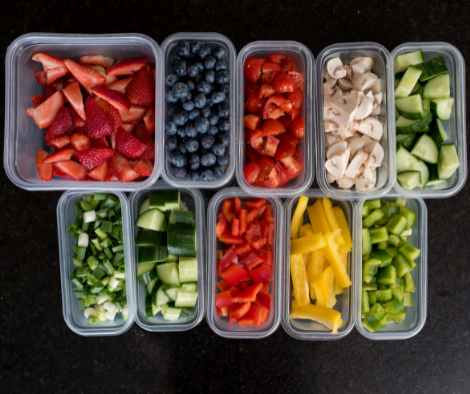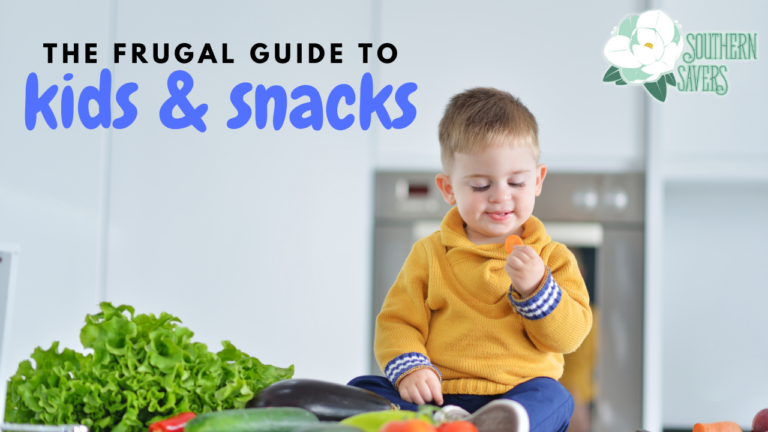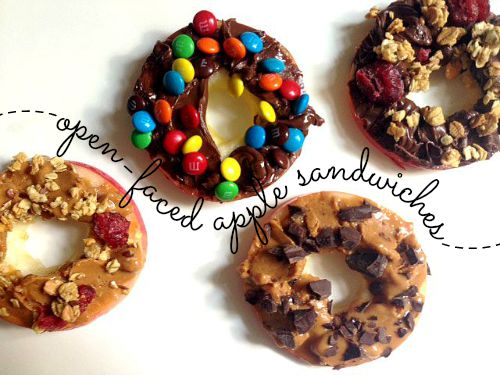The controversies about kids and eating goes back and forth, seemingly endlessly. There are tons of opinions about what you should feed your kids, how often, etc. starting from birth! All of us have different viewpoints and lifestyles, and there’s not one consensus on these issues. But if you’re trying to be frugal and keep to a certain grocery budget, you have probably run into the issue of kids and snacks. These kids are growing, and sometimes it seems like they’re going to eat you out of house and home. But if you let them snack constantly, they won’t eat well at meals and you’ll spend a small fortune on snack foods. What’s a parent to do? Here’s my frugal guide to kids and snacks—take what helps and leave what doesn’t!
The Frugal Guide to Kids and Snacks
Again, there are tons of different opinions on this. I’m just going to share tips that have worked for us as we try to find a healthy balance with kids and snacking!

In order to help snacking, it helps to look at your meals first. Make sure you’re feeding your kids nutrient dense meals with a mix of protein, fat, and carbs. If they eat only a Pop-tart for breakfast, it won’t be surprising when they want a snack an hour later. But if they ate some scrambled eggs, a banana, and a piece of toast and say they’re hungry, you are better equipped to know if they’re really hungry!
When you are eating, sit at the table and don’t allow grazing or excessive eating in front of the TV. When I serve snacks, we sit at our kitchen bar or outside at our little picnic table. We eat our food out of small bowls or off of small plates. Putting a whole bag of something out makes it inevitable that the whole bag will be eaten (or dumped out and wasted by a toddler!)
If you’re struggling with snacks and other eating interfering with kids eating at meals, then save the food they don’t finish at a meal for a future snack. This doesn’t have to be marketed as punishment for not finishing. It is a great way to not waste food and to make sure if kids really are hungry, they’re filling their tummies with good things.

When it comes to actual snacks, snacks aren’t bad! – most experts recommend 1-2 snacks a day depending on when mealtimes are. When my kids were younger, we didn’t usually do a morning snack because breakfast and lunch were only a few hours apart due to afternoon naps. But we always did a substantial snack when they woke up from their nap to get them through until dinner. This may also be true if you have school-aged kids who go to school. Some kids eat lunch at 10:30 am! If they don’t get home until 2:30 or 3, they will definitely need something to tide them over until dinner.
Summers and school breaks can be times when snacking seems to get out of control! If you find this happening to you, have set times for snacks (10 am and 3 pm for example) or have a “snack window” where during that time, snacks are allowed. You can also have times when you say “the kitchen is closed.”

If you don’t want to have to monitor time or snack windows, then you can have “always” snacks like fruit or fresh-cut veggies that are always available.
Another way to keep kids from eating you out of house and home is to make sure your snacks include protein or fiber to help fill up hungry bellies.
If you have multiple kids who can handle the responsibility, you can give each kid their own snack “box” for a certain week/day; when the snacks are gone, they’re gone. This can especially help if some snacks are more exciting. When I buy a certain kind of granola bar, the whole box can be gone in a day if I don’t keep an eye on it.
To keep from spending a small fortune on individually packaged snacks, have nourishing snacks ready in the fridge/freezer. Some of our favorite recipes are apple sandwiches, roasted chickpeas, and chocolate banana muffins! The website 100 Days of Real Food has a great list of 85 snack ideas.
It can also help kids to feel they have a sense of control over their food. That doesn’t mean they always get to choose to eat Little Debbie snacks, though! If you’re planning to make something for an upcoming after school snack, you could give your kids the option of pumpkin muffins or apple muffins, for example.
Another final tip when kids say they’re hungry is to encourage them to have a glass of water! Even adults sometimes feel hunger when they’re actually dehydrated. If the kid is still hungry after a glass of water, then use one of the other tips above!
What are your best tips for dealing with kids and snacks? Let us know in the comments!




